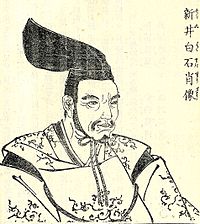Arai Hakuseki
| Arai Hakuseki | |
|---|---|

Japanese book 『先哲像伝』
|
|
| Born | March 24, 1657 Edo |
| Died | June 29, 1725 Edo |
| Occupation | Neo-confucian scholar, academic, administrator, writer |
| Subject | Japanese history, literature |
Arai Hakuseki (新井 白石?, March 24, 1657 – June 29, 1725) was a Confucianist, scholar-bureaucrat, academic, administrator, writer and politician in Japan during the middle of the Edo Period, who advised the Shogun Tokugawa Ienobu. His personal name was Kinmi or Kimiyoshi (君美). Hakuseki (白石) was his pen name. His father was a Kururi han samurai Arai Masazumi (新井 正済).
Hakuseki was born in Edo and from a very early age displayed signs of genius. According to one story, at the age of three Hakuseki managed to copy a Confucian book written in Kanji, character by character. Because he was born on the same year as the Great Fire of Meireki and because he was hot tempered and his brow would crease looking like 火 or "fire", he was affectionately called Hi no Ko (火の子) or child of fire. He was a retainer of Hotta Masatoshi, but after Masatoshi was assassinated by Inaba Masayasu, the Hotta clan was forced to move from Sakura to Yamagata then to Fukushima and the domain's income declined. Hakuseki offered to leave, becoming a ronin and studied under Confucianist Kinoshita Jun'an. He was offered a post by the largest han, that of Kaga Domain, but he offered the position to a fellow samurai.
...
Wikipedia
